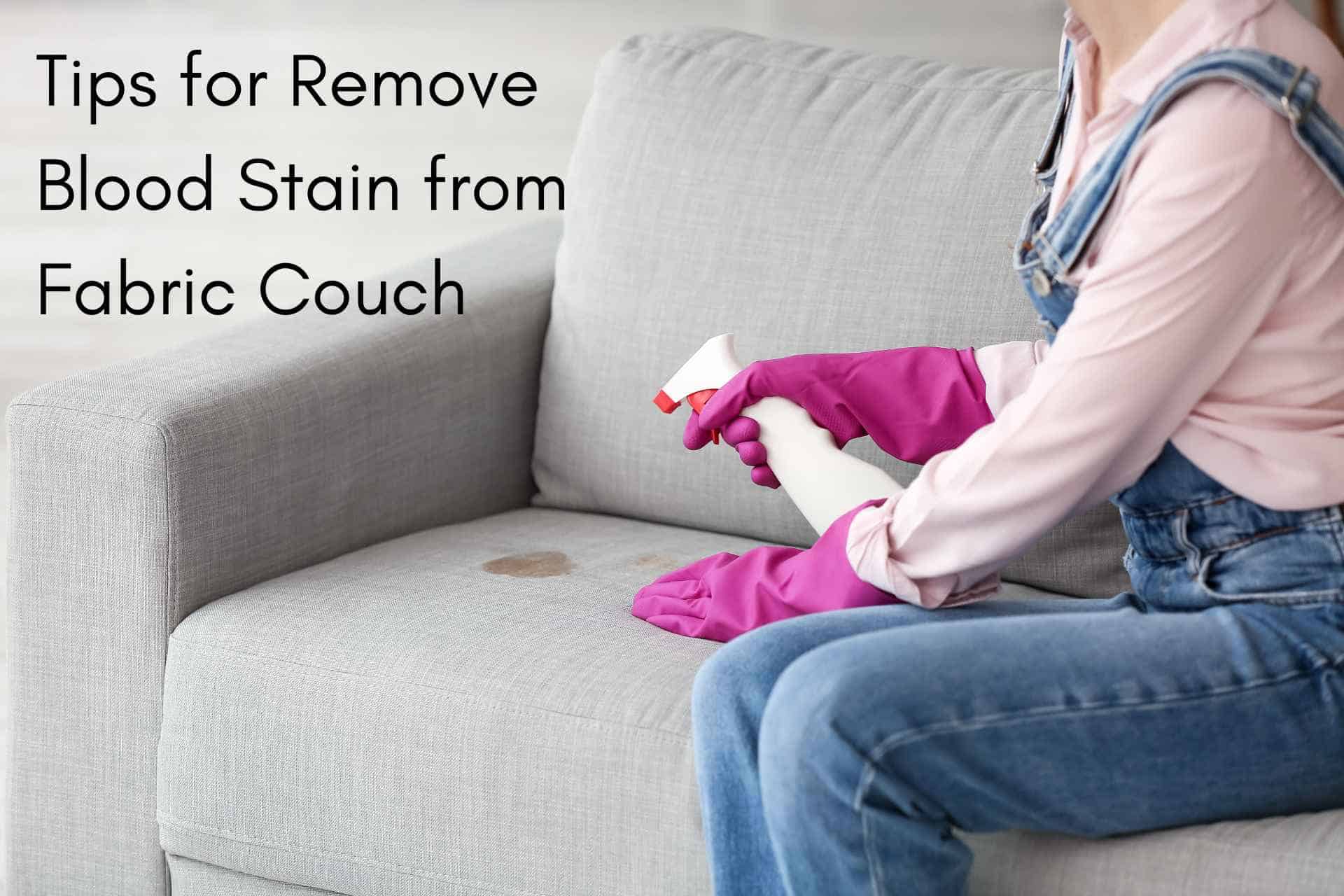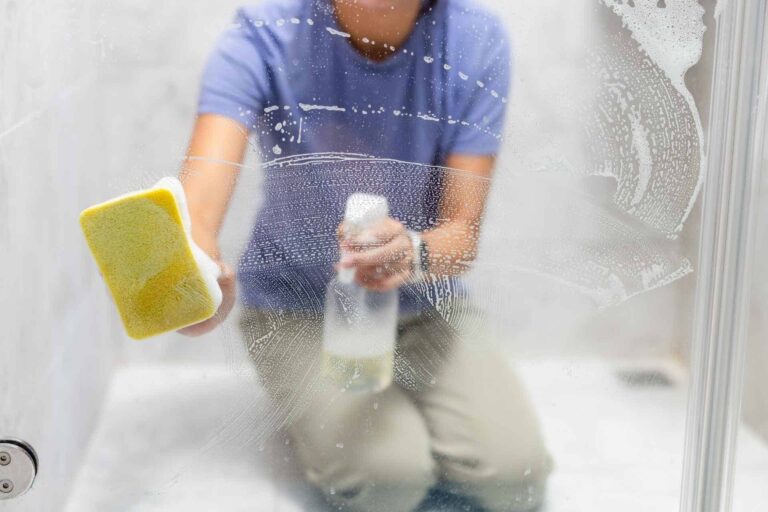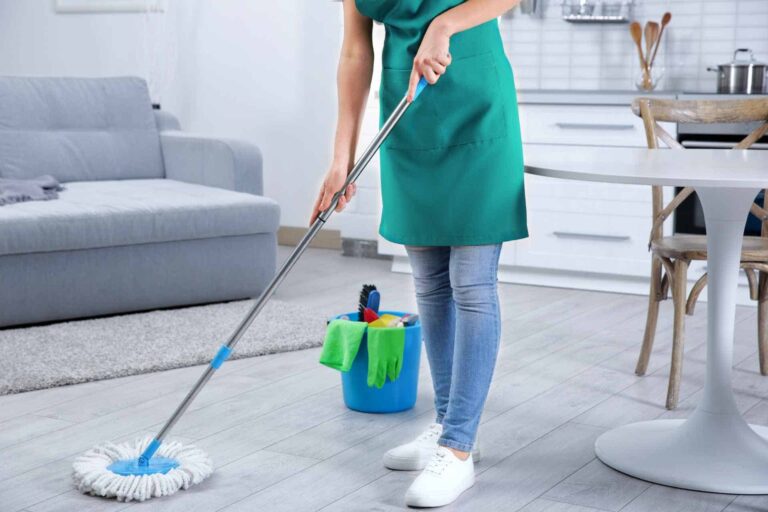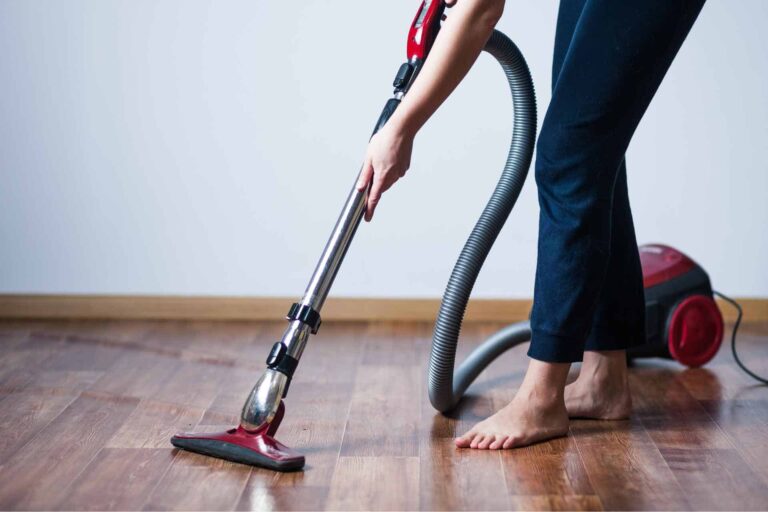How To Get Period Blood Out Of Grey Couch?
Period stains are a common issue, occurring often due to unexpected menstruation or an unforeseen leak. This is particularly evident in households where the couch is a common spot for relaxation and comfort. The unpredictability of these instances, coupled with the nature of period blood, often results in stains that can be quite stubborn to remove. The complexity of the task is further increased by the diverse range of materials used in couches, with each requiring a different cleaning approach. Moreover, the fact that couches are heavy, often immovable objects adds to the challenge, making this a common issue that many people struggle to address effectively. Regardless of these difficulties, prompt and correct action can often lead to successful stain removal, restoring the couch to its original condition.
Let’s dive into the guide on how to get period blood out of Grey Couch…
How To Get Period Blood Out Of Grey Couch? – Initial Steps
Taking Immediate Action
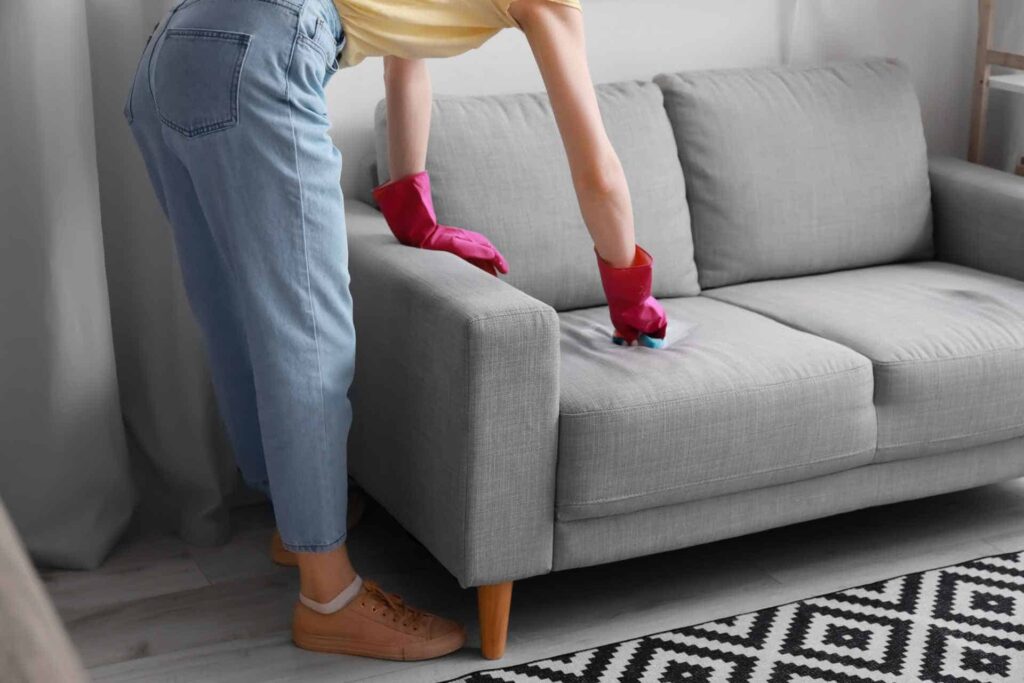
The key to successfully removing a period stain from your couch is immediate action. As soon as you notice the stain, it’s critical to start the cleaning process. This helps to prevent the blood from drying and setting into the fabric, which makes it much harder to remove. Start by blotting the stain gently with a clean, dry cloth to remove as much of the excess blood as possible. Avoid rubbing the stain as this can cause it to spread or penetrate more deeply into the fabric. Remember, the goal at this initial stage is to minimize the spread and impact of the stain.
Removing Excess Blood
Once you’ve blotted the stain to remove any surface blood, the next step is to deal with any excess blood that has soaked into the fabric. To do this, use a mixture of cold water and salt. Cold water is important as hot or warm water can cause the blood to set into the fabric. Make a solution of one part salt to two parts cold water. Apply this solution to the stain and let it sit for 5 to 10 minutes. This will help to draw the excess blood out of the fabric. After the solution has had time to work, blot the area again with a dry cloth to remove the solution and lift the blood. Remember, always use a blotting motion to prevent spreading the stain. Repeat this process until no more blood is coming out.
Cleaning the Stain
Testing for Color Fastness

Before applying any cleaning solution to the stain, it’s vital to test the material of your couch for color fastness. This step ensures the cleaning solution won’t discolor or damage the fabric. Choose an inconspicuous spot on the couch, such as a corner or under a cushion. Apply a small amount of your cleaning solution and gently rub it into the fabric with a clean cloth. Wait for a couple of minutes, then blot it dry. If the color of the fabric remains intact and there are no visible damages, you can safely proceed with the cleaning process. If the color fades or the fabric’s texture changes, you should consider using a different cleaning solution or consult with a professional cleaner.
Applying the Cleaning Solution
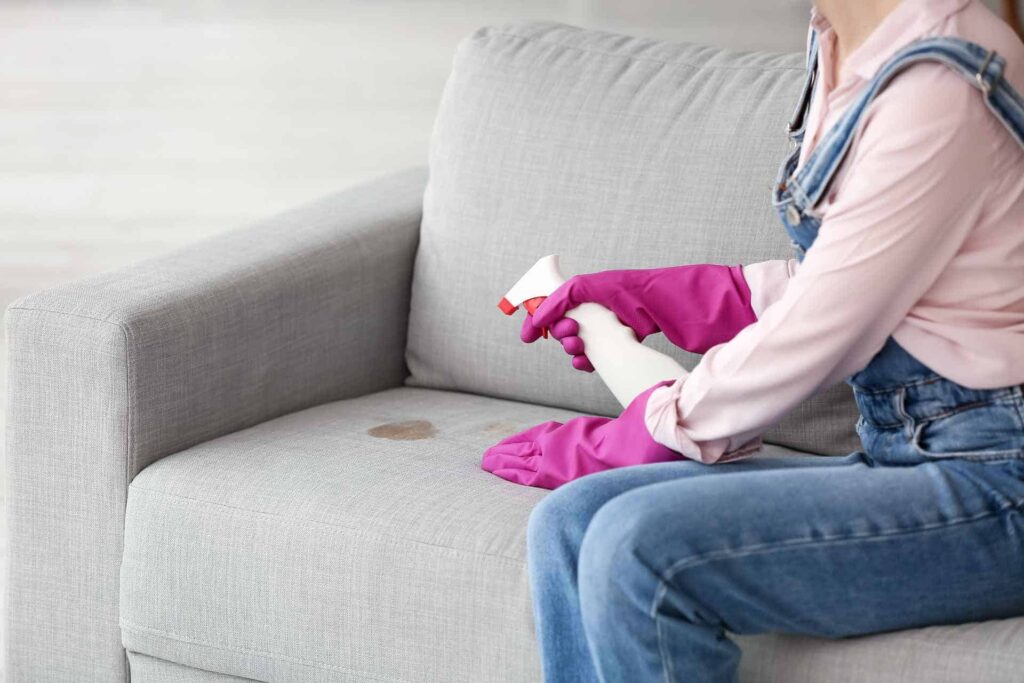
After confirming the color fastness of your couch’s fabric, you can now apply the cleaning solution to the blood stain. Mix one tablespoon of liquid dishwashing soap into two cups of cold water. Using a clean cloth or sponge, gently apply this solution to the stain. Dab at the stain, starting from the outside and working your way towards the center. This process helps prevent the stain from spreading further into the fabric. Let the solution sit for a few minutes to penetrate and break down the blood particles. Afterward, blot the area with a dry cloth to absorb the solution along with the stain. Avoid rubbing or scrubbing as this can push the stain deeper into the fibers. Continue this process until the stain is completely removed.
Techniques for Blotting and Lifting the Stain
Proper blotting and lifting techniques are key to removing a stain effectively without causing further damage to the fabric. Start by using a clean, dry towel or cloth to blot the stain, applying moderate pressure to absorb as much of the stain as possible. Remember, always blot from the outside in – this helps contain the stain and prevents it from spreading. Occasionally shift to a clean part of the towel to avoid re-depositing the stain back onto the fabric. If the stain is still visible, use a gentle lifting motion with a scraping tool such as a spoon or a blunt knife. This helps to lift the stain particles away from the fabric fibers. Be careful not to rub or scrub, as these actions can push the stain deeper into the fabric and potentially cause fiber damage. Repeat these steps as necessary until the stain is no longer visible. Afterward, rinse the area with cold water to remove any remaining cleaning solution. Pat dry with a clean towel and allow the area to air dry completely.
Deep Cleaning
When and How to Deep Clean

Deep cleaning should be undertaken when regular cleaning techniques fail to completely remove the stain, or when the fabric has accumulated dirt and grime over a long period. Begin by preparing a solution of a heavy-duty laundry detergent and warm water, following the ratio specified on the detergent packaging. Immerse the stained fabric into the solution and allow it to soak for at least 30 minutes. This helps to loosen the deeply ingrained stain particles.
Next, gently scrub the affected area with a soft-bristled brush, working in a circular motion. This helps to lift the stain particles from the fabric fibers. Be careful not to scrub too vigorously, as this can damage the fabric. Once the stain begins to lighten, rinse the fabric thoroughly with warm water to remove any remaining detergent.
Lastly, wash the fabric as per usual in the washing machine, using the appropriate setting based on the fabric type. After washing, inspect the fabric for any remnants of the stain. If the stain is still visible, repeat the deep cleaning process until it is completely removed. Always allow the fabric to air dry after washing, as heat from the dryer can set any remaining stain particles, making them harder to remove in the future.
Professional Cleaning Services
When all home-based cleaning methods fail, or if the fabric is too delicate or valuable, it may be time to consider professional cleaning services. These experts have specialized knowledge, techniques, and equipment to effectively eliminate stubborn stains without causing damage. They can also provide advice on how to maintain and protect various types of fabrics, helping to prolong their lifespan. Most professional cleaners offer services for a wide range of items, from clothing and upholstery to rugs and draperies. Remember, it’s crucial to choose a reputable service provider and always check reviews and references before entrusting your items to them.
Prevention and Protection

Preventing future stains is often easier than dealing with them after they’ve occurred. A few simple tips can go a long way in making this possible:
Use Fabric Protectors: Consider using a fabric protector which creates a barrier between the fabric and potential stains. This can be particularly useful for upholstery and clothing that sees frequent use.
Prompt Action: If a spill occurs, acting promptly can prevent a stain from setting. Blot the spill with a clean, dry cloth to soak up as much of the liquid as possible before it seeps into the fabric.
Mindful Usage: Be mindful of consuming food and beverages while wearing delicate clothing or near valuable upholstery. If you must, use napkins or towels as an extra layer of protection.
Regular Cleaning: Regular cleaning of fabrics can prevent dirt and dust from building up and embedding in the material, which can lead to discoloration over time.
Remember, prevention is key when it comes to fabric care, and these simple steps can help keep your textiles looking fresh and stain-free.
Couch Protection Options
Protecting your couch from spills, stains, and everyday wear and tear is essential to prolong its lifespan. Below are a few effective options:
Slipcovers: These are a practical and stylish way to protect your couch. They come in a variety of materials, colors, and patterns, making it easy to match your home decor. Most are machine-washable for easy cleaning.
Furniture Protectors: These are specially designed to protect your couch from spills and stains. They are often waterproof and stain-resistant.
Throw Blankets: A more casual approach, throw blankets can add a pop of color to your living room while protecting your couch. They can be easily cleaned and switched out for a fresh look.
Upholstery Spray: An upholstery protection spray creates an invisible barrier on your couch that repels liquids and prevents stains.
With these options, you can keep your couch looking brand new for years to come.
Conclusion
In summary, maintaining the beauty and longevity of your fabrics, particularly your couch, involves several steps. Mindful usage of your items, avoiding food and drink spills, and regular cleaning are the primary preventive measures. To further protect your couch, consider options such as slipcovers, furniture protectors, throw blankets, and upholstery sprays. Each offers unique benefits and can be selected based on your individual needs and style preferences. Layering these preventive measures and protections can help your textiles and couch retain their fresh, stain-free appearance for years to come.
Don’t be disheartened if your couch has a stain or two – successful stain removal is entirely possible with a bit of knowledge, effort, and patience. Remember, immediate action is critical. The quicker you address the stain, the higher your chances of completely eliminating it. And don’t forget – even the most stubborn stains have met their match in the hands of persistent and informed homeowners. So keep your spirits high, and remember that every stain is just a step away from being a thing of the past!

